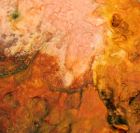Ever wondered about the organisms inhabiting Astoria Hot Springs? In Kristin Revill’s Environmental Microbiology class at JH Community School, students Henry Wolff and Christa Finlay embarked on a mission to uncover these microbial mysteries. They ventured to the outflow streams of the main pools and collected 5 x 5 mm samples of microbial mats. These samples were then sent to the lab for analysis, where DNA extraction was performed to identify the species present. Astonishingly, this technique revealed the presence of nearly 2,000 distinct bacterial species at Astoria Hot Springs.
On your next visit to Astoria, look for these microbial mats. They often appear as brightly colored, spongy, or stringy-textured materials in the outflow streams of all the pools.
Chemotrophs and phototrophs are the two main groups of bacteria. Organisms that get their energy from chemical compounds in their environment, such as organic material, iron, or sulfur minerals, are chemotrophs. On the other hand, phototrophs get their energy from sunlight, like plants. Both types of bacteria exist at Astoria, with the green and pink material being phototrophs and the red likely being chemotrophic, using iron or sulfur for energy.
Living organisms too small to see with the naked eye, microbes play a surprisingly important role in every ecosystem. They are the oldest life forms on earth and exist everywhere—in soil, water, air, and even extreme environments where no life would be expected to exist. Microbes that thrive in harsh environments are called extremophiles. While the thermal pools at Astoria Hot Springs Park (104° F) are not as hot as those in Yellowstone (140°–180° F), many organisms thriving at Astoria are still considered extremophiles.






